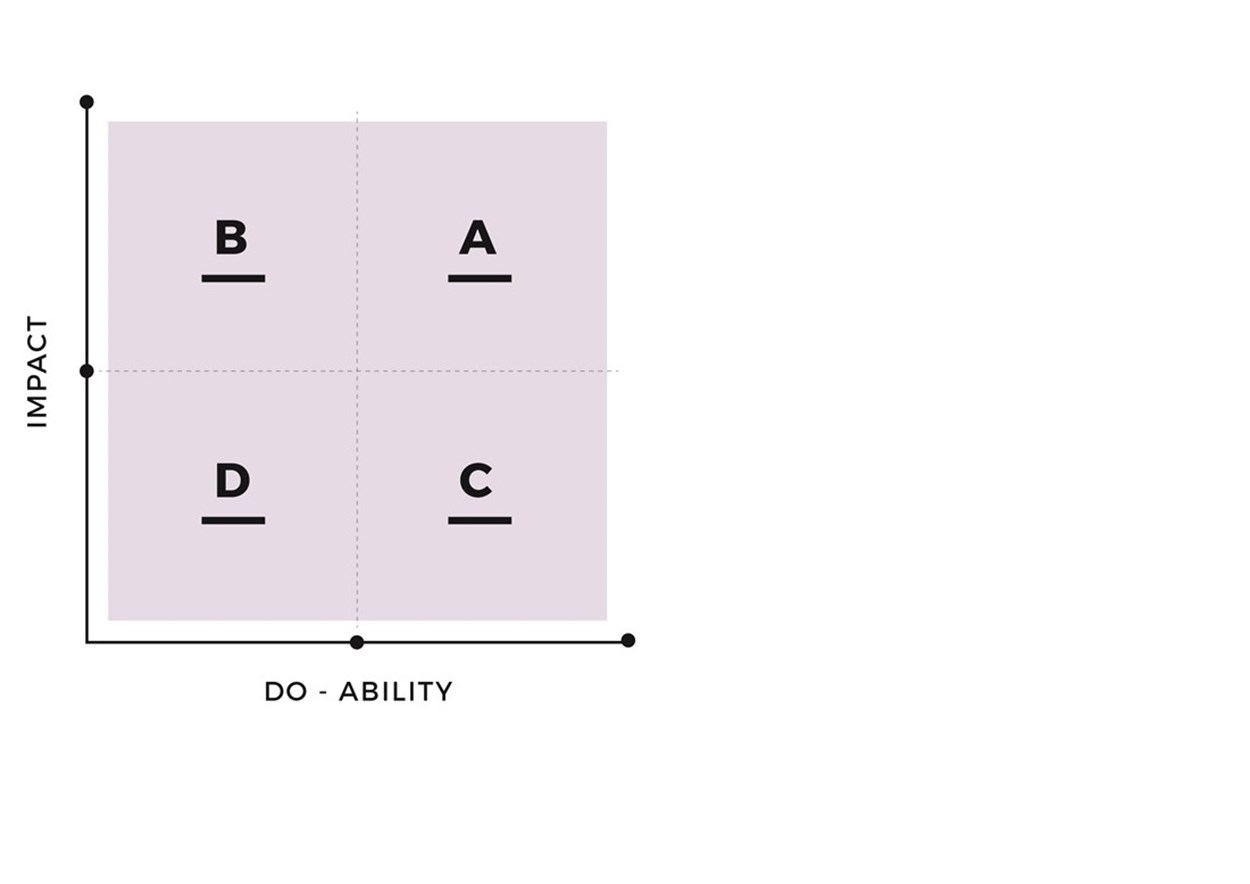A two-by-two matrix for effecting change personally and professionally
Several weeks ago, my colleague Daniel Vacassin wrote this piece on using a two by two matrix to simplify organisational change. It got me thinking about how we can apply this same, incredibly useful, tool to personal development. As you’ll see, there are many similarities, and some subtle but important differences.
Most people can set a destination and create a list of development actions. They've got a view about how they could be a more efficient, well-rounded, effective professional. Unfortunately, in my experience, many people aren’t sure where to start and struggle to keep their expectations realistic.
Plotting the path a journey should follow takes craft. You need to work out not only what needs to be done, but also how, in what order and with whose support.
As the Director of Consultancy for Indigogold, I frequently work with people who, after a certain amount of coaxing, are brimming full of ideas about how they can develop. These same people also often get stuck on what they should tackle first, and how to invest their energy effectively.
There’s a fairly simple tool you can use as a framework for structuring personal development:

Box A - High Impact & Easy
These are often quick wins, small things that make a big difference. They’re not necessarily sexy or complex, but they’re actions that will make a tangible difference at a personal level. These changes are often defined by shorter time horizons, making them quick to implement and yield obvious benefits.
Often, when people are new to a role, this box is full. The list of actions is even longer when you’re moving from a well-established organisation to a younger, less mature one: you have a set of experience to bring to the role and plenty of ‘shaping up’ to do. Once you’re established in a role, and especially in a mature company, there’s often less in this box.
Similarly, as a new leader, there’ll be plenty here for you to get started on, making big steps forward fast. The more experienced individuals will have less in this box; all your ‘easy wins’ may be done and dusted by now, and the more challenging developments in Box B await.
A word of caution: Be realistic when you’re determining the level of impact of each point on your list. People frequently label everything as ‘high impact’, forgetting the golden role of personal development within an organisation: the changes you make need to be visible and tangible to others. So ‘being more organised’ might have a large impact on your internal, day-to-day life, but it probably won’t make a big change to how people experience you, and your position within the organisation as a whole.
You should also be careful not to underestimate the amount of effort needed to develop a particular aspect of yourself. After a couple of coaching sessions, you may feel that a certain change is very ‘doable’ having spoken about it and broken it down into logical steps. But remember that if it were easy, chances are you would have already done it. Impactful personal development often requires the alteration of deep-seated patterns of thought and behaviour. Ask yourself what you need to change in yourself to make this action a reality before you gauge its do-ability.
Approach: Get things moving. Actions in Box A are a great way of building appetite and confidence.
Box B: High Impact & Harder to Implement
This is often longer term, more complex work which is defined by longer time horizons and/or more dependencies on factors not immediately within your control. These changes may need a degree of influence, persuasion or personal resource to complete. Significant rewards are on offer but these generally come hand in hand with similarly significant risks, as you weigh up the effort versus the results.
With most people, extended timescales are necessary for real change. When you put this into an organisational context, you’ll find that it’s very difficult to change your professional self without changing your surroundings to support that new behaviour. The culture and strategy need to be in line with your individual objectives, or there’ll be a discordancy which won’t be easy to work with, and may confound your operational effectiveness.
Generally, it’s a good idea to know what your development needs are, and discuss them with the right people to get the support you need. That way, you can wait for the right opportunity to arise for you to fulfil those goals, and be in a position to exploit it when it does. This works better than trying to force change into a framework that doesn’t yet allow for it.
The key question here is: how do you manage or reduce the risk without diminishing the level of reward? Can the activity be broken up into smaller chunks? Could some of those chunks be included in Box A? Would completing an activity from Box A or C (these are easier to implement) build sponsorship, support and organisational readiness to help reduce the risks associated with this activity?
Remember that making change takes time and energy, and that this will mean that some other area of your work will have to be reduced, or disappear entirely. You need to find the balance between short term operational performance and your own long-term development, which can be a challenge in a fast-moving business. Our recent work with Vodafone was a perfect illustration of this.
A word of caution: Don’t over-engineer it. Set sensible timeframes and simplify where you can, dividing the personal development into manageable and definable stages. Be realistic about how long it will take but make sure the timescales are meaningful. Keep in mind that a five-year change plan may not work in a young technology business, for example – the world is likely to have moved on by the time you reach the end of the plan.
Approach: Take time to build momentum for this work. Plan but don’t over-engineer. Everything in small chunks.
Box C: Easy and Lower Impact
Actions in this box tend to be sub-optimal routines and tasks that can be tuned up, rather than personal capabilities. They’re often within your department, and don’t require influence or resources to be successful. Often ‘tidying’ activity, these actions can be motivating, increasing professionalism and coherence.
A word of caution: On the flip side, it’s important to assess the extent to which these measures will actually change your organisational profile. If you aspire to become a general manager, for example, improving these things may not be impactful enough to get noticed.
Ensure that these actions don’t become an ‘easy out’ for the bigger tasks in Boxes A and B, which will yield far more significant results. They can make you feel busy and like you’re making effort, but lack real impact. Only take these tasks on when you have already put sufficient time and energy into the measures in Boxes A and B.
Approach: Helpful for tidying up. Activities in this box can be a good investment, laying the foundation of support for good personal performance.
Box D: Low Impact, Low Do-ability
These measures may still be in your plan because someone told you that they should be at some point, and you’ve hung onto them as a way of diverting your energy from more challenging, impactful changes.
Alternatively, they could be the legacy of an older set of objectives that need bringing up to date with your current circumstances. You may still be indulging them because they’ve become habitual, a part of your ‘toolkit’ that you return to by default.
Indulging the tasks in this box will make you a ‘busy fool’, giving the illusion of effort without actually achieving anything of worth. They’re a distraction masquerading as development.
A word of caution: Activities in Box D bleed your time and energy, and any investment here is simply wasteful. Take a look at your own habitual ways of doing things to make sure they don’t fall into this area.
Approach: Either avoid this activity completely, or challenge yourself to reframe the actions in this box to make them valuable and impactful in your current situation.
To see this tool in action for organisational change, take a look at its partner article here.
Connect with Indigogold on LinkedIn for regular insights from our team of search and consultancy experts.

